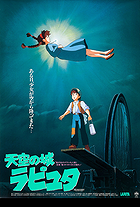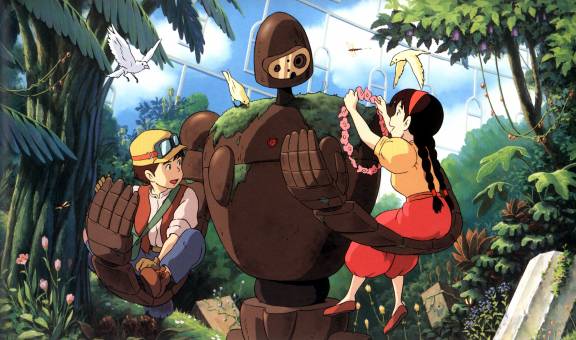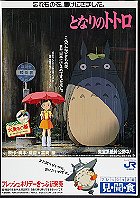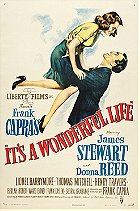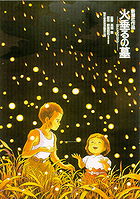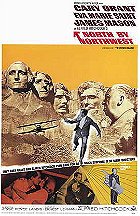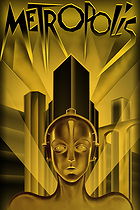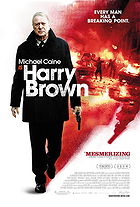When an unconfident young woman is cursed with an old body by a spiteful witch, her only chance of breaking the spell lies with a self-indulgent yet insecure young wizard and his companions in his legged, walking home.
Christian Bale: Howl
Hauru no ugoku shiro(2004), known to us as Howl's Moving Castle was greeted with numerous reviews not equaling those that Spirited Away received, which is understandable yet undeserving. Miyazaki tells his tale outside the parameters of Western storyline structure. Taking liberties with every aspect, telling it how he wants it to be told, and at first it is a little strange because of the failure recognitive of classic plot points we are so used to seeing; critics have marked it as below par Miyazaki on account of this. I find this ridiculous, and so does Miyazaki. In an interview Miyazaki said "The fact that you would expect a story to be told a certain way is ridiculous." I quite agree Mr. Miyazaki.

The film is among his best, abundant in rich imagination and delightful characters set in a world of fantastical sights and sounds, Where everyone has a fly-machine(Miyazaki is an aviation fanatic), where wizards walk among the common folk.
The film was not released in the United Kingdom until 23 September 2005, yet Director Hayao Miyazaki personally travelled to England in the summer of 2004 to give a private showing of the film to Diana Wynne Jones, a very respectful act. Dianne Wynne Jones, the writer of the book Howls Moving Castle; upon which this film is based combines the essence of the story Jones wrote with the style and art of Miyazaki.
The premise and plot; Young Sophie Hatter is cursed by the Witch of the Waste, and turns into an old hag. Ashamed of how she looks, she flees into the hills where a moving castle roams the hills. This castle known to belong to the young and handsome wizard Howl; whom has a bad reputation. Within the castle, Sophie befriends the fire demon Calcifer who promises to help her become young again. One catch, she must help Calcifer to be free of Howl, and Calcifer cannot tell her how. However, Sophie agrees to stay and try and find out about the contract threw other ways. Still, Howl can see that Sophie is under a spell (like Calcifer can) and falls in love with her for who she is and not what she looks like. Sophie manages to bring life to the moving castle, and help Howl to face his former tutor, Madam Sulimen.
Howl's Moving Castle is riddled with classic Miyazaki: strong women characters, open landscapes, flying machines that are so fantastical you don't care whether the make sense or not, and the horridness of war. These add strength to the love story of Howl and Sofi. Miyazaki uses his wonderful power to take classic, almost mythological and fantasy laden story of Dianne Wynne Jones we all know, and archetypal characters and make them a vision of his own making. He does this with a host of wonderful characters. More strange creatures play prominent role here then any other Miyazaki film.
The film even sometimes surpasses Spirited Away in sheer scope and majesty. There is Calcifer, the wonderfully comic fire demon, on Turniphead; the Scarecrow that leads Sofi to Howl's magical moving castle. The castle itself is one reason to see the film. Miyazaki succeeds in giving the castle life and personality. It lumbers along on its thin chicken-like legs, every atom of it's being pushing, pulling, pumping and gyrating in perfect synchronization.
What is truly mesmerizing about Howl's Moving Castle is how it reaches the imagination and fantasy that Spirited Away had; while with the subtlety and moral splicing of Princess Mononoke while standing on its own in perfectly unique way. There have been complaints of lack of proper character development, but like the point before this is no ordinary story. The characters are thrust into a world they do not know, and there they must adapt, and live outside what they have known all their lives. It is not a story of who they were, but what they have become, or what they must become in order to meet their existences purpose. It does not dwell on the past, and gets into the thick of the story; not pausing for flashback explanations we have come to know. It is like nothing I have ever seen before.
To summarize the whole experience : the American voice casting is brilliant, possibly the best assemble ever on a Miyazaki film, which is saying quite alot. Billy Crystal, Christian Bale(Upon seeing Miyazaki'sSpirited Away, Christian Bale immediately agreed to play any role in this film), Lauren Bacall, Jean Simmons and others provide perfect voice overs. Please, if you enjoy Miyazaki and you have not seen this yet, I recommend you do as soon as possible for you will of course fall in love with it. To summarize
Hayao Miyazaki's achievement with making a visionary film from a book should be summed up by the writer. A fitting way to end my review and sum up the film would be to quote Diana Wynne Jones thoughts on the film, "It's fantastic. No, I have no input - I write books, not films. Yes it will be different from the book; in fact it's likely to be very different, but that's as it should be. It will still be a fantastic film." Take her word for it and mine; It IS a fantastic film.
''You who swallowed a falling star, o' heartless man, your heart shall soon be mine. That can't be good for the table.''
 Login
Login
 Home
Home 24 Lists
24 Lists 448 Reviews
448 Reviews Collections
Collections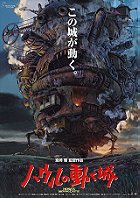
 0 comments,
0 comments, 